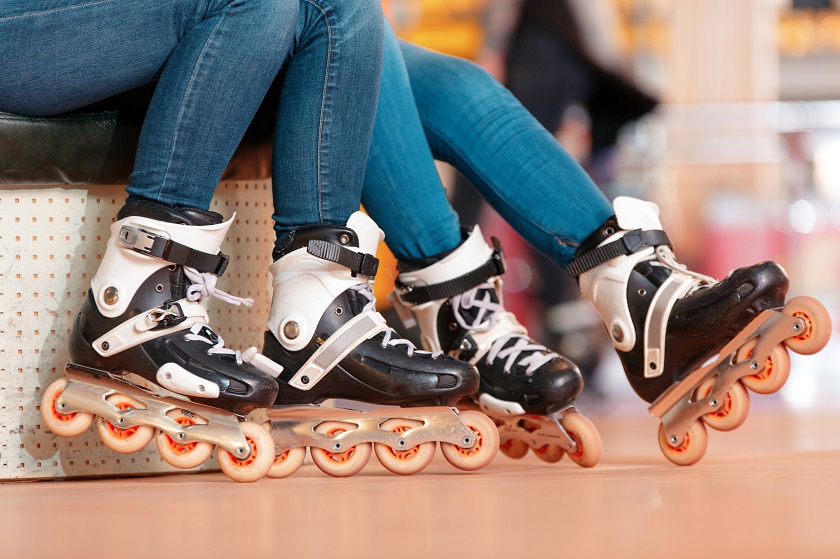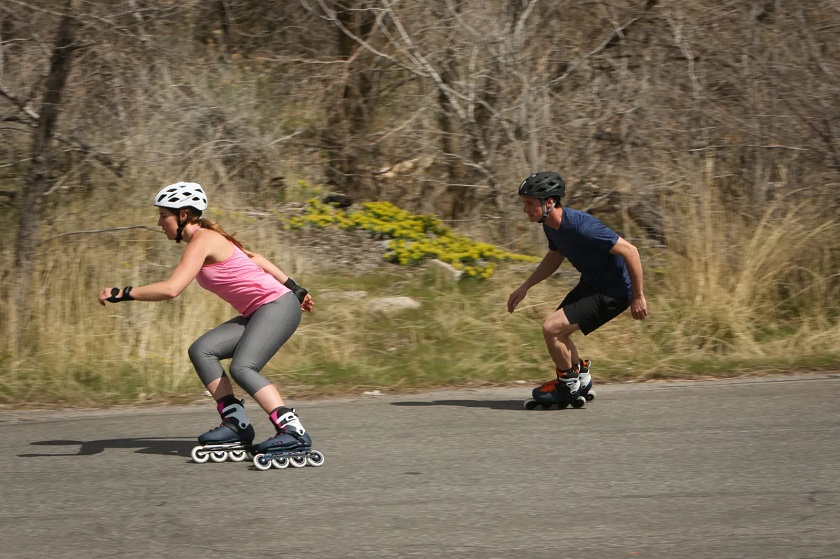Inline skating is a great way to move around on wheels, whether for exercise, socializing, or enjoyment. Inline skates are typically utilized for fast travel on smooth surfaces. The name “inline skates” comes from having four wheels in a straight line behind each other. This results in a smoother, faster ride with less effort. Unlike roller skates, some inline skates feature larger wheels and higher-quality bearings for improved speed, making them perfect for the more serious skater who demands the best performance.
Contents
Inner Skate Parts

Wheels-Sizing and Hardness
You need the right inline skating wheels for optimal performance. Novices should keep in mind two crucial things: the sizes and the hardness of the wheel, written right on the side of the wheel.
Standard inline skates typically have 70-76 mm wheels, which provide a low and stable centre of gravity. On the other hand, inner fitness skates feature larger diameter wheels, up to 80 mm, to enable faster skating. Additionally, small skating wheels are ideal for lower-skilled skaters because of their high stability and control. Large wheels are usually reserved for more experienced skaters who want to go faster. For those who want to enjoy the benefits of large wheel skating without sacrificing too much stability or control, we recommend a 3 wheel skate. Their shorter frames that allow for improved manoeuvrability make people of all skill levels enjoy the huge wheel experience.
Durometers are used to measure the hardness of a wheel. A softer wheel has a lower number, whereas a harder wheel has a higher number. The suffix “A” stands for durometer, for example – 80A. 78A or 82A is the common recreational in-line skate wheel. Harder wheels are better in the summer when the surface is hot and the wheels tend to soften, while softer wheels are better in the winter and provide a smoother ride.
Frames
A frame is the skate’s part that holds all the components in place. Recreational frames are usually made of aluminium alloy, nylon, and fibreglass composites. Ensure that the frames you choose are appropriate for the skating style you intend to do. For instance, metal frames are more rigid, quicker, and lighter, but they are also more expensive.
Liners
Many boots have a cushioning liner, usually constructed of foam material. Liners are sometimes strengthened along the toe and sides for protection and greater stability.
Hard Shell

Similar to a ski boot, but made of moulded plastic. The lower half covers and protects the foot, while the upper half wraps around and supports the ankle. A hinge system connects the two sections, allowing the ankle and boot to stretch forward naturally.
Soft Boot
The soft boot features an external and sometimes internal plastic sleeve to give support. It offers a superb fit and performance while remaining extremely breathable and light.
Bearings
Each wheel has two bearings in the centre. The ABEC rating of each bearing reflects the precision with which it was manufactured. The higher the rating, the more precise the manufacturing and the faster the performance will be. You do not need to clean the bearings after each usage, but you should clean and dry them if they become wet.
Brakes
Different manufacturers offer different types of brakes. The most popular type of braking mechanism is a pad or cylinder on the back wheel that applies pressure on the heel to stop movement. However, hockey and speed skates do not have braking systems.
The “wear line” on most brake pads indicates how much performance remains in the brake. Before this wear line is reached, the brake pad should be replaced. Some manufacturers offer mechanical braking systems, making stopping easier to learn.
Inner Skates’ Types

Aggressive Skates
These skates are specially designed for leaping, sliding, and grinding. Aggressive skates feature skating wheels under 60mm because they have a low centre of gravity, making it easier to perform and land tricks. Since small wheels restrict speed, some skaters prefer Aggressive skates with slightly larger wheels, up to 80mm, known as Power roller blades.
Recreational Skates
If you’re a beginner or casual skater looking for new inner skates, you should consider the recreational type. Comfort and stability are prioritized, with a loose fit that requires little to no break-in time. To maintain a low price, these skates omit high-end performance characteristics. Recreational skates are suitable for short, low-intensity skating sessions.
True novices should limit their search to skates with small wheels,78-80mm. This will keep the speed low while maintaining a great level of control.
Speed Skates
If properly suited to your foot, the extra firm construction of Speed Skates enables optimal power transmission for distance or marathon aficionados skating at a competitive level. They usually require heat moulding and are uncomfortable right out of the box.
The low-cut shape of speed boots provides for a full range of motion, allowing for a longer, stronger stride and a superior edge on the huge wheels. Rather than starting with this style of boot, a skater would have to work their way up to it. Entry-level speed skates have somewhat higher cuffs for increased support, but they’re not the same as skates for complete beginners.
Important Factors to Consider When Buying the Right Inline Skates

Gender
Men’s models are made to fit the shape of a man’s foot. Women’s models are created with women in mind. For a better fit to the female body, the cuffs are often slightly lower than those seen in Men’s models, and the forefoot is occasionally significantly wider. Unisex skates are very popular, particularly in more specialized skate varieties such as speed or slalom. These skates are designed for both men and women and are based on men’s sizing. Skates for boys and girls are the same size and fit, but the colours will differ.
Skill Level
Skates made for beginners, and returning skaters who are unsure about their abilities are supportive, sturdy, and comfy. They include smaller wheels and a brake for a slower, more regulated speed, allowing confidence and skill to grow.
Intermediate level skates demand current or previous skating experience and trust in your ability to turn and halt. If you’ve been out of the game for a while, a beginning or intermediate skate with skating wheels no larger than 4x84mm or 3×110 can help you regain control and speed.
Advanced level skaters will profit from a higher performance skate within each category, regardless of your skating. Your abilities will put pressure on the skate to perform, and you may be able to outperform basic, lower-level skates.










